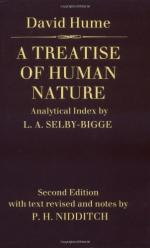If in considering the nature of relation, and that facility of transition, which is essential to it, we can satisfy ourselves concerning the reality of this phaenomenon, it is well: But I must confess I place my chief confidence in experience to prove so material a principle. We may, therefore, observe, as the first experiment to our present purpose, that upon the appearance of the picture of an absent friend, our idea of him is evidently inlivened by the resemblance, and that every passion, which that idea occasions, whether of joy or sorrow, acquires new force and vigour. In producing this effect there concur both a relation and a present impression. Where the picture bears him no resemblance, or at least was not intended for him, it never so much as conveys our thought to him: And where it is absent, as well as the person; though the mind may pass from the thought of the one to that of the other; it feels its idea to be rather weekend than inlivened by that transition. We take a pleasure in viewing the picture of a friend, when it is set before us; but when it is removed, rather choose to consider him directly, than by reflexion in an image, which is equally distinct and obscure.
The ceremonies of the Roman Catholic religion may be considered as experiments of the same nature. The devotees of that strange superstition usually plead in excuse of the mummeries, with which they are upbraided, that they feel the good effect of those external motions, and postures, and actions, in enlivening their devotion, and quickening their fervour, which otherwise would decay away, if directed entirely to distant and immaterial objects. We shadow out the objects of our faith, say they, in sensible types and images, and render them more present to us by the immediate presence of these types, than it is possible for us to do, merely by an intellectual view and contemplation. Sensible objects have always a greater influence on the fancy than any other; and this influence they readily convey to those ideas, to which they are related, and which they Resemble. I shall only infer from these practices, and this reasoning, that the effect of resemblance in inlivening the idea is very common; and as in every case a resemblance and a present impression must concur, we are abundantly supplyed with experiments to prove the reality of the foregoing principle.




